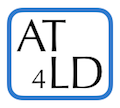AT4LD is designed to provide participants with the knowledge, skills, and confidence to make informed decisions about the selection and implementation of assistive technology supports for students with learning and thinking differences – brain-based learning difficulties that include learning disabilities, ADHD, and executive functioning deficits, plus issues with processing information and memory.
This is a beginner to intermediate level course, appropriate for those looking to add assistive technology to their practice or their skill set, and those familiar with AT who want to delve into the nuts-and-bolts of creating effective solutions.
At the conclusion of the course, participants should be able to:
- Provide a working definition of assistive technology (AT) devices and services in the context of accommodations for learning.
- Explain the principles of Universal Design for Learning (UDL), and provide examples of how technology can facilitate practicing UDL in the classroom and why accessible educational materials (AEM) are important to students using AT.
- Demonstrate understanding of how specific technology tools address the functional limitations that students with learning differences encounter with a wide range of academic tasks, including:
- Reading and comprehension
- Writing and composition
- Math and calculation
- Processing verbal and nonverbal learning
- Memory retention and retrieval
- Attention and self-regulation
- Organization, planning, and productivity.
- Apply a process for analyzing an individual's AT needs and creating a plan to implement selected tools and strategies.
- Name and differentiate between the main laws that govern AT in education and describe their implications for students with learning differences.
See the Course Outline page for a more detailed look at what you will learn.
